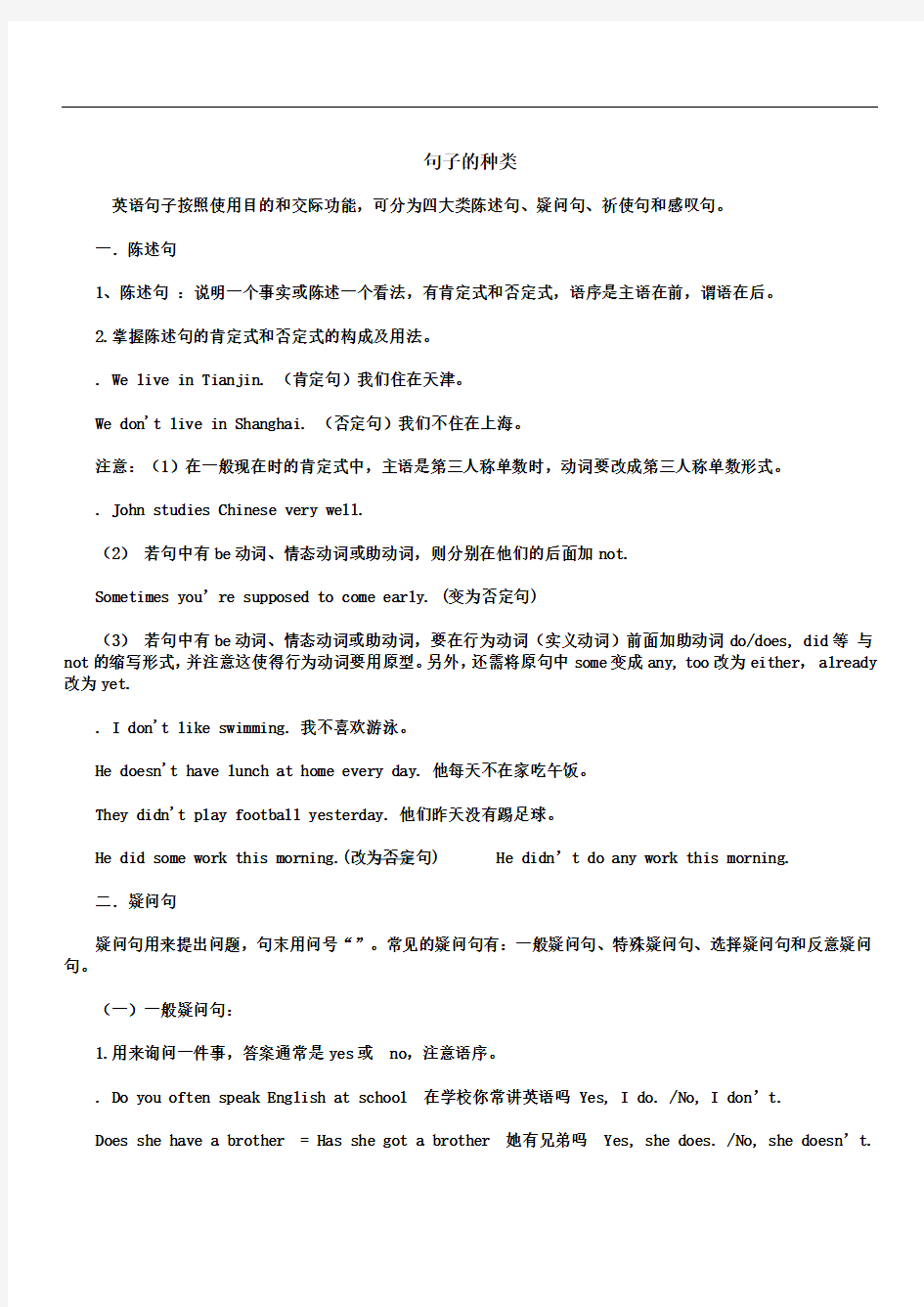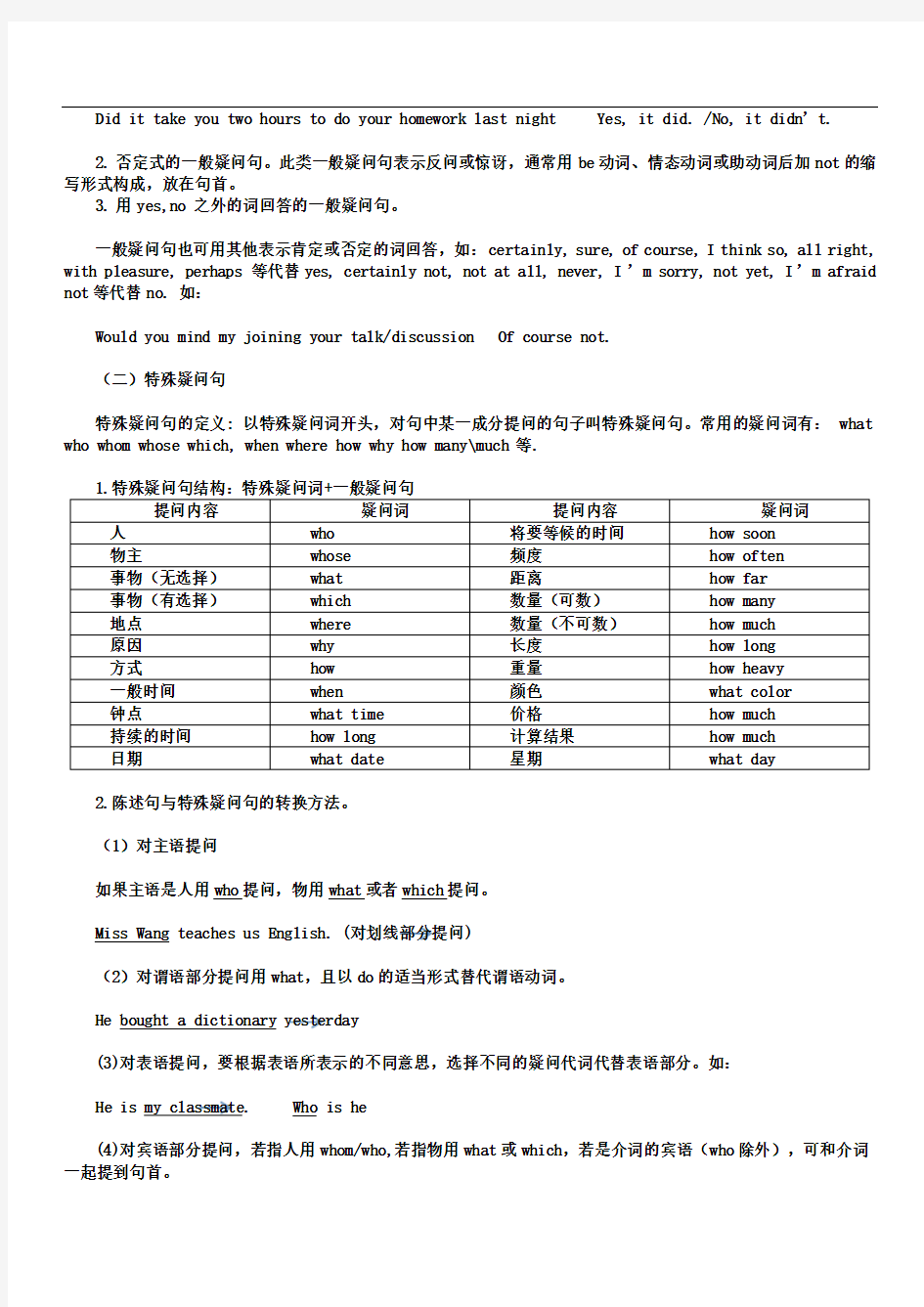初中语法句子种类讲解


句子的种类
英语句子按照使用目的和交际功能,可分为四大类陈述句、疑问句、祈使句和感叹句。
一.陈述句
1、陈述句:说明一个事实或陈述一个看法,有肯定式和否定式,语序是主语在前,谓语在后。
2.掌握陈述句的肯定式和否定式的构成及用法。
. We live in Tianjin. (肯定句)我们住在天津。
We don't live in Shanghai. (否定句)我们不住在上海。
注意:(1)在一般现在时的肯定式中,主语是第三人称单数时,动词要改成第三人称单数形式。
. John studies Chinese very well.
(2)若句中有be动词、情态动词或助动词,则分别在他们的后面加not.
Sometimes you’re supposed to come early. (变为否定句)
(3)若句中有be动词、情态动词或助动词,要在行为动词(实义动词)前面加助动词do/does, did等与not的缩写形式,并注意这使得行为动词要用原型。另外,还需将原句中some变成any, too改为either, already 改为yet.
. I don't like swimming. 我不喜欢游泳。
He doesn't have lunch at home every day. 他每天不在家吃午饭。
They didn't play football yesterday. 他们昨天没有踢足球。
He did some work this morning.(改为否定句) He didn’t do any work this morning.
二.疑问句
疑问句用来提出问题,句末用问号“”。常见的疑问句有:一般疑问句、特殊疑问句、选择疑问句和反意疑问句。
(一)一般疑问句:
1.用来询问一件事,答案通常是yes或 no,注意语序。
. Do you often speak English at school 在学校你常讲英语吗 Yes, I do. /No, I don’t.
Does she have a brother = Has she got a brother 她有兄弟吗 Yes, she does. /No, she doesn’t.
Did it take you two hours to do your homework last night Yes, it did. /No, it didn’t.
2.否定式的一般疑问句。此类一般疑问句表示反问或惊讶,通常用be动词、情态动词或助动词后加not的缩写形式构成,放在句首。
3.用yes,no 之外的词回答的一般疑问句。
一般疑问句也可用其他表示肯定或否定的词回答,如:certainly, sure, of course, I think so, all right, with pleasure, perhaps 等代替yes, certainly not, not at all, never, I’m sorry, not yet, I’m afraid not等代替no. 如:
Would you mind my joining your talk/discussion Of course not.
(二)特殊疑问句
特殊疑问句的定义: 以特殊疑问词开头,对句中某一成分提问的句子叫特殊疑问句。常用的疑问词有: what who whom whose which, when where how why how many\much 等.
2.陈述句与特殊疑问句的转换方法。
(1)对主语提问
如果主语是人用who提问,物用what或者which提问。
Miss Wang teaches us English. (对划线部分提问)
(2)对谓语部分提问用what,且以do的适当形式替代谓语动词。
He bought a dictionary yesterday
(3)对表语提问,要根据表语所表示的不同意思,选择不同的疑问代词代替表语部分。如:
He is my classmate. Who is he
(4)对宾语部分提问,若指人用whom/who,若指物用what或which,若是介词的宾语(who除外),可和介词一起提到句首。
如:He is looking for the little boy. Who is she looking for
(5)对定语提问,提问部分是修饰主语的定语,句子的语序不变,提问部分修饰宾语或表语的定语时,必须把替代提问部分的疑问词和它所修饰的词放在句首。
The man in blue is my uncle.
(6)对状语部分进行提问。若对状语部分提问,时间when,(几点几分用what time),地点where,原因why, how。
(7)固定句型地特殊疑问句
It’s windy today.
It’s Monday today.
He is outgoing.
(三)选择疑问句
选择疑问句是说话者对问题提出两个或两个以上的答案,供对方选择其一。这种疑问句有两种形式:一种以一般疑问句为基础,另一种以特殊疑问句为基础。Or连接的两个并列成分可以是状语、宾语、表语、谓语或是两个句子等。
(1)一般选择疑问句(以一般疑问句为基础)
. Is her brother an artist or a doctor
她的兄弟是一个艺术家还是个医生
Would you like tea or coffee
你愿意喝茶还是喝咖啡
Shall we go to the cinema on Saturday or on Sunday
我们是周六还是周日去电影院
(2)特殊选择疑问句(以特殊疑问句为基础)
Who is taller, Mike or Jimmy
Which would you like, cola or tea
(四)反意疑问句
反意疑问句表示提问者有一定的主见,但没把握,希望对方来证实。注意反意疑问句的结构是:肯定的陈述句+否定的疑问句(缩略形式)或:否定的陈述句+肯定的疑问句(缩略形式),必须遵循的原则是“三同一反”:
两部分的人称、时态、动词相同,前肯后否,前否后肯。
注意: 否定的疑问句中的助动词必须缩写,主语(最后一个词)必须是代词而不能是名词。
1.结构一:前肯,+ 后否
eg. He is clever, isn’t he
结构二:前否,+ 后肯
eg. He isn’t clever, is he
. Your sister has ever been to Shanghai , hasn't she
你姐姐曾经去过上海是吗
The boys didn't find anything , did they
男孩子们什么也没找到/发现,是不是
2. 在回答反意疑问句时,要根据事实而定,事实是肯定的要回答Yes , …,事实是否定的要回答No, ….
注意在前肯后否的反意疑问句中,yes“不”,No “是”
. He isn't going to the meeting , is he
他不去参加会,是吗
Yes , he is . 不,他要去。
No , he isn't. 是的/对,他不去。
It didn't snow last week , did it
上周没有下雪,对吗
Yes , it did. / No , it didn't. 不,下雪了。是的,没下雪。
3.no/not之外的否定意义的反意疑问句。若陈述句中含有表否定意义的词,如never,hardly, few, little, seldom 等,在构成反意疑问句时,附加疑问部分仍用肯定式。
Maria has few friends,
4.句中含否定前缀的反意疑问句。若陈述部分含有带否定前缀的词,如dislike, unhappy, untrue, impossible, disagree 等,依然要把陈述句看做肯定句,反意疑问部分用否定式。
He dislikes volleyball,
5.主语为不定代词的反意疑问句。若陈述句主语是表物的everything, something, anything, nothing,疑
问部分的主语用it.
Nothing has been considered about this meeting, hasn’t it
三.祈使句
1.表达命令、要求、请求、劝告等,用原形。
. Go back to your seat , please. 请回到你的座位上去。
Don't make so much noise. 不要吵吵闹闹。
's go to school together ! 咱们一起上学去吧!
Let him help the child. 让他帮助那个孩子。
注意:否定形式是Let's (us , me)+not +动词原形
. Let's not say anything about it.
对于这件事,咱们什么也不要说了。
3.有时为了委婉,可在句首或句尾加上please,若加在末尾,前面要用逗号隔开。
Please sit down.
Stand up, please.
4.某些名词、形容词或副词等后面加感叹号,也可作为祈使句使用。
Hands up. Hands down.
四.感叹句
表示喜怒哀乐等强烈感情时用感叹句,理解由What和How引导的感叹句的语序和感叹句的使用方法。How和What与所修饰的词放在句首,其它部分用陈述句语序。在口语中谓语常省略。
(1)how作状语,修饰形容词,副词或动词
结构:How+形容词/副词+主语+谓语
How+主语+谓语
How + 形容词 + a(an) + 单数可数名词 + (主语 + 谓语)
How nice the flowers are ! 花多漂亮啊!
How hard he works ! 他工作的多努力啊!
How time flies!时间过得真快啊!
How good an example he set ! 他树立了一个多好的榜样啊!
(2)what作宾语,修饰名词(名词前可有其他定语),单词可数名词前要加不定冠词a(an). 结构:What a (an)+形容词+名词+主语+谓语
What +形容词+不可数名词+主语+谓语
What +形容词+可数名词复数+主语+谓语
. What a clever girl (she is )! 她是一个多么聪明的女孩啊!
What delicious food ! 多么好吃的食物啊!
What important jobs they have done. 他们做了多么重要的工作啊!
What fresh milk (it is)!
What fun!
反意疑问句练习
mom bought me a medium coke,______ went to your grandma's home,________
will go home,________ doesn't like to eat apples,_______
room looks so big,_______ won't sleep early,_________
are never late for school,_______ watched the football match last week,______ mother is cooking,__________ father plays the computer very well,__________
were moved by your students,________ makes us healthy,______________
sewing machine can make the clothes,_____ mother doesn't enjoy smoking,_____
don't want to bo a teacher in the future,________ look so happy today,________
三、把下列的句子改为感叹句。(答案不唯一)
1.A: Jill is drawing a beautiful picture. B: ___________________________
2.A: Mr Wang is a busy man. B: ___________________________
3.A: The cat is very happy. B: ___________________________
4.A: The tractor is going very slowly. B: ___________________________
5.A: He is very lucky . B: ___________________________
6.A: It is a wet day today. B: ___________________________
7.A: They started early. B: ___________________________
8.A: They waited a long time B: ___________________________
9.A: He is wearing a large shirt. B: ___________________________
10.A: The dolphin is playing happily. B: ___________________________
